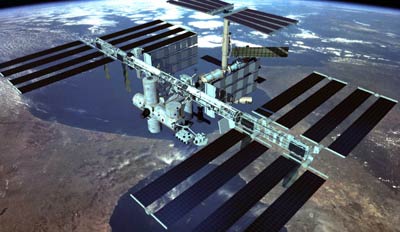The Dinkin Commission report (part 2)by Sam Dinkin
|
| Hold an auction for the US portion of the ISS immediately. Have the ownership be encumbered by US space program users for the next few years, but get the government out of the business of owning and operating the station. |
The best way to do this is financially. The federal government can guarantee that it can help space development and private space transportation by funding a subsidy. By paying commercial space transporters for every pound of third-party payload they deliver, the space transporters will use the money for whatever support they need most, whether that is legal, engineering, management, advertising, or whatever. A direct subsidy is better than a tax break. A subsidy pumps money into space whether space firms are making money or losing money. Tax breaks only help firms that are making money. With strong entry in the early years, tax breaks will only help the ultimate winners. The tax break capped at five times investment such as the one recommended by the Aldridge Commission will discourage high-risk investments. If there are 100 ventures and one succeeds and is worth 1000 times the initial investment, capping the tax break at five times the initial investment will increase the total return by less than one percent. Low-risk projects would have money flood into them, however, so the cap may well not limit the taxpayer liability. For example, suppose all semiconductor manufacturing and pharmaceutical manufacturing moves off earth, but it cost 25% more for 100% certainty. That investment would be made if the tax break is big enough while the wildly-profitable risky investment would not be.
Another good way to support the development of space is to spend money on shared services that can be built and deployed cheaper by a single entity than everyone doing it themselves. Terrestrial examples are traditional public goods such as roads, bridges and ports. Examples for the space industry on Earth would be subsidizing launch facilities, good regulation, venture investment, and promotion of space activities. More far-sighted ideas for shared services are shared communications/GPS constellation around the Moon and Mars so that individual spacecraft can have the hardware of a satellite phone and a GPS locator instead of much more self-contained navigation and communications suites. If you cannot invent the space internet, at least you can build it.
What differentiates these technologies and services is that they are technology-neutral and service-neutral; useful for whatever propulsion scheme and whatever mission type ultimately gets launched. By investing in mature technologies, the high-risk, high-payoff technologies can be shifted to the private sector where innovation and creativity can achieve exciting fast developments.
To promote that technology development, the federal government should generously support space research on topics of the private sector’s choosing. There should be a general research subsidy.
| Another good way to support the development of space is to spend money on shared services that can be built and deployed cheaper by a single entity than everyone doing it themselves. |
The Department of Space Security should also undertake its own research program with the 10% of dollars that it does not spend outside the agency. Some of the 90% should be spent on directed research. Again, the research direction should be functional only. That is, questions like “How can I get to space for less than $100/lb” are OK. “Is a hypersonic airbreathing engine feasible?” is not OK. The research should be like DARPA or NSF. The Department of Space Security should take a light hand and leave it to customer organizations to pull relevant research from the private sector.
Two technologies where there is high leverage are affordable heavy lift and high-bandwidth communications. Space elevators might get there once they are proven.
Bootstrapping heavy lift might be a big win. By creating a depot for water, oxygen, hydrogen and other bulk items in space, the heavy-lift infrastructure can be juiced while making sure that the investment has some return. This fueling station also is a shared service allowing lighter lift for interplanetary missions and high Earth orbit missions. This was described at Space Access ’04.
In Earth orbit, high-bandwidth communication might be combined with spy satellites. If spy satellites became common carriers like the Boeing refueling lease-back deal where communications, private images, and other shared facilities of the spysats were used, ultimately a much denser system could be afforded.
